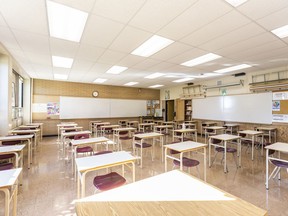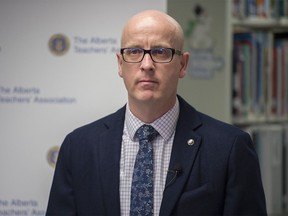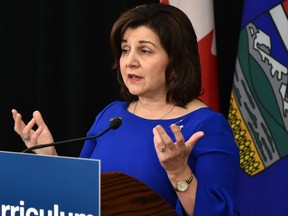‘Teachers are taking mental health leave, retiring early or just leaving the profession altogether. And it’s because of the stress on the system. Teachers don’t feel supported’

article content
Class sizes are expected to rise this fall as teachers, burned out by the pandemic and an expressed lack of support, take stress leave or retire early and school boards struggle with fixed funding.
Announcement 2
article content
Teacher surveys and data from local school boards indicate an exodus of educators in the past two years, with teachers taking furloughs and fewer teachers on staff than before the pandemic, including fewer educational assistants in the public system.
At the same time, school boards like the Calgary Board of Education were forced to dip into reserves to balance their budgets this spring after fixed funds from the UCP government failed to meet their growth needs.
“We anticipate an increase in class sizes in the system this fall and fewer teachers are expected to be in classrooms,” said Medeana Moussa, a spokeswoman for the advocacy group Support Our Students.
“Principals are left to fend for themselves, with less funding for their schools, and are forced to lay off librarians, gym teachers, and especially special education teachers who work with small groups of high-needs students.”
Announcement 3
article content
Union leaders say they are also concerned that there will be fewer teachers this fall, which means larger classes across the province, especially in the largest urban centers.
“We will see larger class sizes simply because boards will not have the funds to adequately staff their classrooms. Classes are getting bigger, but there are also more complexities inside these classrooms than ever before,” said Jason Schilling, president of the Alberta Teachers Association, adding that substitute teachers will also be leaving.
“It’s going to be a serious problem in the fall, because we’re not going to see that many substitute teachers on the roster either.
“COVID is still impacting classrooms, and many substitutes are simply choosing not to be placed in the substitute pool until they see better supports in the classroom.”
Announcement 4
article content

The ATA has collected survey data from teachers during the pandemic, and the most recent survey completed in late 2021 indicates the number of Alberta teachers planning to leave the profession for another job this fall has more than doubled.
The “P” in ATAUlse survey” conducted in late November suggests that more than 37 percent of respondents reported that they are unlikely to teach in Alberta in the coming year.
Compared to an annual member opinion survey conducted last March, the number of teachers who planned to retire was similar, at 16 percent, but the percentage who said they were going to look for another job doubled, rising to 14 percent. hundred.
“We have seen this trend in our surveys during the pandemic,” Schilling said.
ad 5
article content
“Teachers are taking mental health leave, retiring early, or just leaving the profession altogether. And it’s because of the stress on the system. Teachers don’t feel supported.”
At the same time, the CBE expects 6,502 teachers and 527 educational assistants in schools this fall, down from the 6,661 teachers and 667 EAs they had on staff in 2019, just before the pandemic.
The Calgary Catholic School District was unable to provide the number of staff for this fall, but confirmed that in 2021 they had 3,233 teachers, up from 3,418 in 2019. However, the number of education assistants increased from 489 before the pandemic to 532. in 2021.
The teacher reduction adds to concerns from both boards this spring that they received fixed funding from the province — essentially the same amount of operating dollars they received in the previous budget year.
ad 6
article content
In late May, the CBE trustees passed $1.37 billion budget for 2022-23, totaling just $142 less than last year budget even though an additional 1,500 students are expected in September.
Parents are also deeply concerned about staffing levels, as well as a growing lack of transparency about exactly how full classrooms are.
Just before the pandemic, the UCP government quietly removed a grant for the class size initiative, providing $3.4 billion over a decade to reduce class size.
Along with that funding cut, the requirement for school boards to report class sizes annually to the province was dropped, and Education Minister Adriana LaGrange has promised to create a new initiative to reduce class sizes.
ad 7
article content

The province has encouraged individual school boards to continue to report average class sizes on their websites, but neither the CBE nor the CCSD are doing so.
“We do not formally track system-wide class size data,” said CBE spokeswoman Joanne Anderson.
“School principals work to balance the complexity and range of student needs in classes in a way that will optimize the experience for all students within available resources.”
CCSD’s Sandra Borowski added, “Currently, Calgary Catholic does not track district-wide class size averages.”
But Moussa is skeptical, explaining that principals have little funding to work with and that families have a right to know class sizes in a publicly funded school system.
ad 8
article content
“Not tracking class sizes, and not being transparent, is a huge disservice to our communities and to taxpayers,” he said, adding that anecdotally, parents have reported class sizes 1st grade is 35 kids and 12th grade classes up to 45. .
“It is vital that we have this information and that families understand what kind of environment their children are in, and that the lack of support that teachers are receiving is understood.”
Katherine Stavropoulos, LaGrange’s press secretary, explained that in early 2020 the Alberta government refocused its priorities on the pandemic, meaning the 2019 initiative to look at class size could not continue.
“As we approach the 2022-23 school year, our focus continues to be supporting students affected by the pandemic,” he said.
“This includes the recently announced investment of an additional $110 million over three years to address mental health, specialized assessments and supports for learning loss.”
